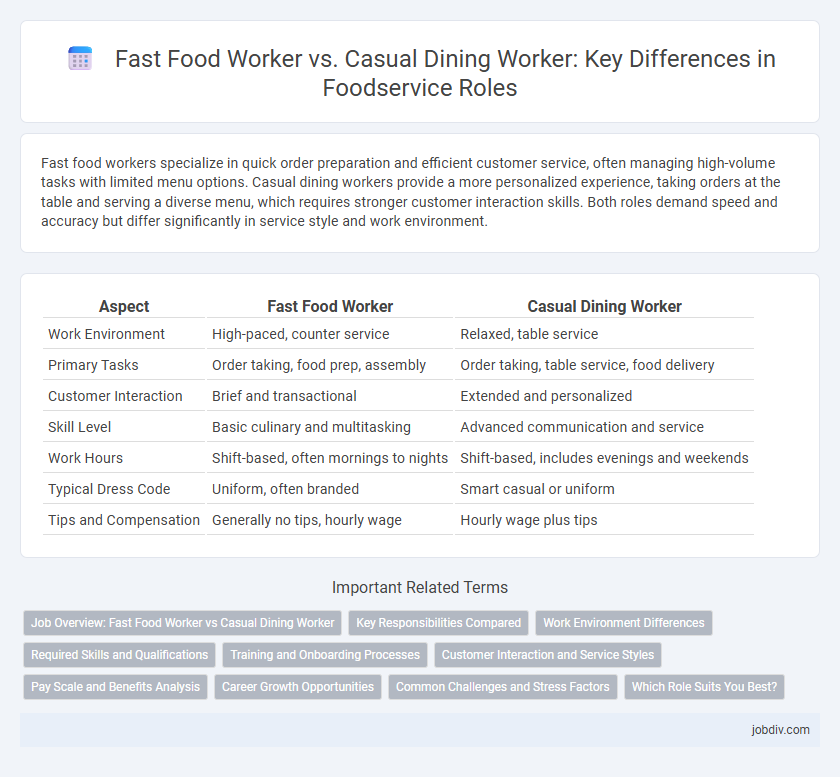Fast food workers specialize in quick order preparation and efficient customer service, often managing high-volume tasks with limited menu options. Casual dining workers provide a more personalized experience, taking orders at the table and serving a diverse menu, which requires stronger customer interaction skills. Both roles demand speed and accuracy but differ significantly in service style and work environment.
Table of Comparison
| Aspect | Fast Food Worker | Casual Dining Worker |
|---|---|---|
| Work Environment | High-paced, counter service | Relaxed, table service |
| Primary Tasks | Order taking, food prep, assembly | Order taking, table service, food delivery |
| Customer Interaction | Brief and transactional | Extended and personalized |
| Skill Level | Basic culinary and multitasking | Advanced communication and service |
| Work Hours | Shift-based, often mornings to nights | Shift-based, includes evenings and weekends |
| Typical Dress Code | Uniform, often branded | Smart casual or uniform |
| Tips and Compensation | Generally no tips, hourly wage | Hourly wage plus tips |
Job Overview: Fast Food Worker vs Casual Dining Worker
Fast food workers handle high-volume orders with a focus on speed and efficiency, often performing repetitive tasks like food preparation, cashiering, and maintaining cleanliness in a fast-paced environment. Casual dining workers engage in table service, providing a more personalized dining experience by taking orders, serving food and beverages, and addressing customer needs in a relaxed setting. Both roles require strong customer service skills, but casual dining workers typically possess more extensive product knowledge and multitasking abilities due to the complexity of menu options and interaction with guests.
Key Responsibilities Compared
Fast food workers specialize in rapid order processing, food assembly, and maintaining high-speed service efficiency to meet peak demand. Casual dining workers focus on table service, detailed menu knowledge, and personalized customer interactions to enhance the dining experience. Both roles require teamwork, cleanliness, and adherence to food safety standards, but casual dining emphasizes customer service quality over speed.
Work Environment Differences
Fast food workers typically operate in high-speed, repetitive environments with standardized menus and limited customer interaction, emphasizing efficiency and speed. Casual dining workers experience a more relaxed atmosphere allowing for personalized customer service, diverse menu options, and longer dining periods. The fast food setting demands quick turnaround and multitasking under pressure, whereas casual dining involves teamwork and communication to enhance guest experiences.
Required Skills and Qualifications
Fast food workers require strong multitasking abilities, rapid order processing, and basic food safety knowledge to handle high-volume, fast-paced environments effectively. Casual dining workers need excellent interpersonal skills, menu knowledge, and experience in table service to deliver a personalized dining experience and manage customer interactions smoothly. Both roles typically demand basic food handling certifications and the ability to maintain cleanliness and safety standards.
Training and Onboarding Processes
Fast food workers undergo streamlined training programs focused on speed, consistency, and handling high-volume orders efficiently, often lasting one to two weeks. Casual dining workers receive more comprehensive onboarding, emphasizing customer service, menu knowledge, and multitasking, with training spanning several weeks to ensure a quality dining experience. These distinctions reflect operational demands, where fast food prioritizes rapid skill acquisition and casual dining values detailed preparation for personalized service.
Customer Interaction and Service Styles
Fast food workers typically engage in brief, transactional customer interactions emphasizing speed and efficiency, often taking orders at counters or drive-thrus. Casual dining workers provide a more personalized service experience, including table service, menu recommendations, and attentive customer engagement to enhance the dining atmosphere. Both roles require strong communication skills, but casual dining demands greater interpersonal interaction and longer customer engagement times.
Pay Scale and Benefits Analysis
Fast food workers typically earn an hourly wage ranging from $10 to $15, with limited access to benefits such as health insurance or paid time off. In contrast, casual dining workers often receive higher pay, averaging $12 to $18 per hour, along with enhanced benefits including health coverage, retirement plans, and employee discounts. Employers in casual dining prioritize retention by offering comprehensive benefits packages that fast food establishments rarely provide.
Career Growth Opportunities
Fast food workers often experience rapid entry-level job placement with limited upward mobility focused on basic managerial roles, while casual dining workers benefit from more varied skill development, enabling advancement into supervisory, culinary, or specialized service positions. The casual dining sector typically offers structured training programs and opportunities for cross-functional experience, contributing to stronger career growth trajectories. Employers in casual dining also tend to invest more in employee development, resulting in higher wage potential and long-term career stability.
Common Challenges and Stress Factors
Fast food workers face intense pressure from high customer turnover and strict time constraints, leading to repetitive stress and physical fatigue. Casual dining workers often manage more complex orders and customer interactions, increasing emotional labor and multitasking demands. Both roles experience high rates of workplace stress due to fast-paced environments and unpredictable workloads.
Which Role Suits You Best?
Fast food workers excel in fast-paced environments requiring quick service and multitasking, often handling high customer volumes with standardized menus. Casual dining workers benefit from stronger interpersonal skills, delivering personalized customer experiences through table service and menu knowledge. Assessing your preference for speed and structure versus customer interaction and a relaxed pace helps determine the best role fit in foodservice.
Fast Food Worker vs Casual Dining Worker Infographic

 jobdiv.com
jobdiv.com